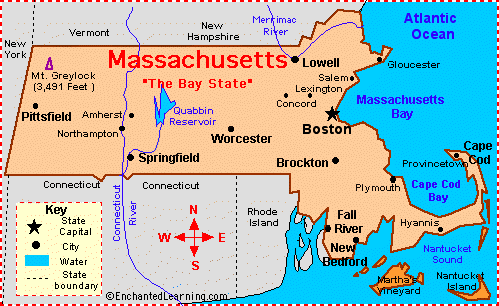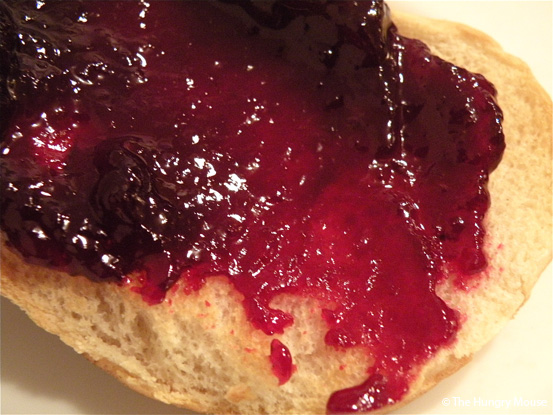They are one of the things, along with apple cider, that for me, embody fall. Those late October days when it's sunny but the air is crisp and you catch a whiff of the fallen, drying leaves, I swear sometimes I can also smell Concord grapes on the air. Mm-mm.

You can almost smell these Concord grapes, can't you?
(Photo by the Apple Lady)
Eating Them
- Concord grapes are one type of purple grapes. They're known as slip-skin grapes, meaning the skin isn't attached to the meat of the grape. (Ah, so that's what allows me to pop the skin off of them and eat the skin and the innards separately.)
- Other purple grapes from Europe are not slip-skin grapes. For some reason, this means it's easier to ship them than it is to ship Concords.
- The Concord Grape Association says
"you don't really 'chew' Concords - you suck them out of their skin to get the juice and flavor and swallow the grape whole (after you separate the seeds). You eat them somewhat like oysters."
- I'm glad to see this because I thought my family were the only ones who ate Concord grapes this way. The skin on its own is pretty tart and I usually don't eat it. Sometimes I'll chew the innards and spit out the seeds, but usually I swallow the insides whole.

Nice, plump Concord grapes showing off their protective white bloom.
(Photo by the Apple Lady)
- The white coating on the grape is called the "bloom." This is a protective coating that's found on many types of grapes and also on blueberries. It's a naturally-occurring oleanolic acid which the grapes themselves produce to keep the fruit from losing essential moisture.
- It's harmless to us, so it's no cause for alarm. You'll want to rinse the grapes before eating as you would with any fruit, and that usually takes off most of the bloom. A little light rubbing will remove the rest.
History
- Concord grapes were first cultivated in 1854 in Concord, Massachusetts. Hence, the name.

Concord is a little place north and west of Boston.
(Map from the Massachusetts Hokkaido Association)

Ephraim Wales Bull, the first guy to cultivate the Concord grape.
(Photo from the American Indian Health and Diet Project)
- Ephraim Wales Bull used seeds of the wild, native purple grapes which grew near his house. His home and farm, by the way, were "just down the road" from the homes of Ralph Waldo Emerson, Henry David Thoreau, Nathaniel Hawthorne, and Luisa May Alcott.
- It's thought that he may have crossed two varieties, the Vitis labrusca and the Catawba.
- After planting some 22,000 seedlings, he hit on a variety that he liked best. It ripens early which means it avoids being killed by the fall frost, and it still has a rich, full flavor.
- A 100-year-old descendant vine from his original seedlings still grows near where Bull once lived.

This is Ephraim's house, now called Grapevine Cottage. Apparently it's for sale, priced at $799,000. It comes with the gravestone which reads "He reaped, others sowed," referring to the fact that he died quite poor, as well as the 100-year old grapevine.
(Photo from Elizabeth Bolton, realtor in Cambridge, MA)
Growing Them Today
- Despite the plant's roots in New England, more than half of today's Concord grapes are grown in Washington.
- The next-highest producing states in descending order of production are New York state, Michigan, Pennsylvania, Ohio, and Missouri.

This particular box of Concord grapes came from Michigan.
(Photo by the Apple Lady)
- The Lake Erie Concord Grape Belt, which is a stretch of land along the northwestern edge of New York state, is the largest grape-growing region in the United States outside of California. It encompasses 30,000 acres of grapes grown on 800 different vineyards. This is where the Welch family started their commercial grape juice business.

The Lake Erie Concord Grape Belt
(Map from the Lake Erie Concord Grape Belt Heritage Association)

Concord grapes on the vine. Here the bloom is very visible.
(Photo from the world wide wine)
- Most Concord grapes are turned into grape juice or jam because few people like to deal with the seeds.
- Concord grapes are sometimes used to make wine, though not so often any longer because the wine they turn into is intensely sweet. Some Kosher wines are still made with Concord grapes.

Concord grape jam. That's some good-looking jam, isn't it?
(Photo from the Hungry Mouse)
Now I'm hungry for a peanut butter & jelly sandwich.
Sources
Concord Grape Association, The History of Concord Grapes
Washington State University Cooperative Extension, Concord Grape Establishment and Production Costs in Washington, 1996
Dan DeClerico, This Old House magazine, A History of the Concord Grape
Spade & Spatula, The Off-the-Beaten-Track Grape Guide and 3 Easy Recipes, October 10, 2011
The American Indian Health and Diet Project, Food Indigenous to the Western Hemisphere, Grapes
World's Healthiest Foods, Grape
Pretty good post. Really great, I hope you create more in the future..
ReplyDelete